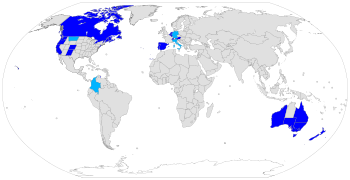
Back انتحار بمساعدة الغير Arabic Köməkli intihar Azerbaijani Suïcidi assistit Catalan خۆکوژی بە ھاوکاری CKB Asistovaná sebevražda Czech Assistierter Suizid German Suicidio asistido Spanish Abistatud enesetapp Estonian Suizidio lagundu Basque خودکشی کمکی Persian
| Suicide |
|---|

Assisted suicide describes the process by which a person, with the help of others, takes medications to die by suicide.[1]
The term usually refers to physician-assisted suicide (PAS), which is an end-of-life measure for a person suffering a painful, terminal illness.[2] Once it is determined that the person's situation qualifies under the laws for that location, the physician's assistance is usually limited to writing a prescription for a lethal dose of drugs. Voluntary euthanasia, meanwhile, is a related but distinct practice where the doctor has a more active role (euthanasia). Both fall under the concept of the right to die.
PAS is legal in some countries, under certain circumstances, including Austria, Belgium, Canada, Germany, Luxembourg, the Netherlands, New Zealand, Portugal, Spain, Switzerland, parts of the United States and all six states of Australia. The constitutional courts of Colombia, Germany and Italy have legalized assisted suicide, but their governments have not yet legislated or regulated the practice. In most of those states or countries, to qualify for legal assistance, individuals who seek a physician-assisted suicide must meet certain criteria, including: they are of sound mind, voluntarily and repeatedly express their wish to die, and take the specified, lethal dose by their own hand. The laws vary in scope from place to place. In the United States, PAS is limited to those who have a prognosis of six months or less to live; in this sense, it is a similar qualification to being put on hospice. In other countries, such as Germany, Canada, Switzerland, Spain, Italy, Austria, Belgium and the Netherlands, a terminal diagnosis is not a requirement, and voluntary euthanasia is additionally allowed.
In some countries and jurisdictions, helping a person kill themself is illegal.[3] People who support legalizing PAS want the people who assist in a voluntary death to be exempt from criminal prosecution for manslaughter or similar crimes.
- ^ "assisted suicide". Encyclopaedia Brittanica. 30 October 2023. Archived from the original on 9 November 2023. Retrieved 8 November 2023.
- ^ "physician-assisted suicide". July 2020. Archived from the original on 9 November 2023.
- ^ "Spain passes law allowing euthanasia". BBC News. 18 March 2021. Archived from the original on 25 December 2021. Retrieved 12 November 2021.